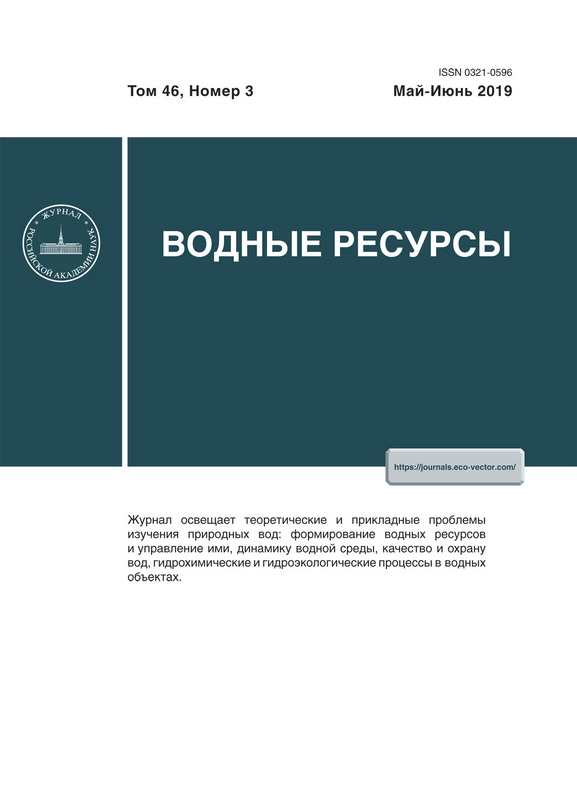Concentration and composition of hydrocarbons in the river Ural mouth zone in the period of high water
- Autores: Nemirovskaya I.A.1, Konovalov B.V.1
-
Afiliações:
- Shirshov Institute of Oceanology, Russian Academy of Sciences
- Edição: Volume 46, Nº 3 (2019)
- Páginas: 303-307
- Seção: Гидрохимия, гидробиология, экологические аспекты
- URL: https://journals.eco-vector.com/0321-0596/article/view/13389
- DOI: https://doi.org/10.31857/S0321-0596463303-307
- ID: 13389
Citar
Texto integral
Resumo
High concentrations of hydrocarbons were detected in the surface water suspended solids of the near-mouth zone of the river Ural during periods of high water level. On average, 198 and 270 μg/l suspended solids were detected in 2016 and 2017, respectively. Weathered oil alkanes were prevalent in the composition of hydrocarbons. The hydrocarbon content was low in sands with an average of 7.8–14.6 μg/g. Terrigenous high-molecular mostly stable alkanes predominated in their composition. The interannual variability of the content of organic compounds is connected with the river runoff and the supply of oil contaminants is connected with the flood water. The Ural River’s runoff during high-water periods is expected to significantly affect the ecological conditions of the North Caspian Sea.
Palavras-chave
Texto integral
Sobre autores
I. Nemirovskaya
Shirshov Institute of Oceanology, Russian Academy of Sciences
Autor responsável pela correspondência
Email: nemir@ocean.ru
Rússia, Moscow
B. Konovalov
Shirshov Institute of Oceanology, Russian Academy of Sciences
Email: nemir@ocean.ru
Rússia, Moscow
Bibliografia
- Гершанович Д.Е., Грундульс З.С. Взвешенные вещества в водах Северного Каспия // Тр. ВНИРО. 1969. Т. 65. С. 57–84.
- ГОСТ 17.1.4.02-90. Вода. Методика спектрофотометрического определения хлорофилла а. М.: Госкомприроды, 1990. 16 с.
- Загрязняющие вещества в водах Волжско-Каспийского бассейна. Астрахань: “Сорокин Р.В.”, 2017. 406 с.
- Качество морских вод по гидрохимическим показателям. Ежегодник 2014 / Под ред. Коршенко А.Н. М.: Наука, 2015. 156 с.
- Коновалов Б.В. Содержание и состав морской взвеси в приустьевой зоне р. Урал в апреле 2016 г. // Науч. альманах. 2016. № 10–2 (24). С. 268–274.
- Кравчишина М.Д., Новигатский А.Н., Политова Н.В. и др. Исследование биогенной и абиогенной частей взвеси реки Волги в период весеннего половодья (май 2008 г.) // Вод. ресурсы. 2013. Т. 40. № 2. С. 151–164.
- Лисицын А.П. Современные представления об осадкообразовании в океанах и морях // Мировой океан. Т. 2. М.: Науч. мир, 2014. С. 331–571.
- Немировская И.А. Нефть в океане (загрязнение и природные токи). М.: Науч. мир, 2013. 432 с.
- Немировская И.А., Островская Е.В. Изменчивость взвеси и органические соединения в седиментационных процессах водосбора Волги и в Северном Каспии // Материалы XXII Международной научной конференции (Школы) по морской геологии. М.: ИОРАН, 2017. Т. 5. С. 333–338.
- Перечень рыбохозяйственных нормативов предельно допустимых концентрации и ориентировочно безопасных уровней воздействия вредных веществ для воды водных объектов, имеющих рыбохозяйственное значение. М.: Росрыболовство, ВНИРО, 1999. 304 с.
- Система Каспийского моря. М.: Науч. мир, 2016. 480 с.
- Monitoring of hazardous substances in the White Sea and Pechora Sea: harmonisation with OSPAR’s Coordinated Environmental Monitoring Programme (CEMP). Tromsø: Akvaplan-niva, 2011. 71р.
- Tolosa I., Mora S., Sheikholeslami M.R. et al. Aliphatic and Aromatic Hydrocarbons in coastal Caspian Sea sediments // Mar. Pol. Bul. 2004. V. 48. Р. 44–60.
- Yunker М.В., Macdonald R.W., Ross N.P.S., Dangerfiel J.S. Alkane and PAH provenance and potential bioavailability in coastal marine sediments subject to a gradient of anthropogenic sources in British Columbia, Canada // Organic Geoch. 2015. № 89–90. Р. 80–116.
- https://semey.city/novosti-semeya/24788.
Arquivos suplementares









